
2017 is quickly drawing to a close. ’Tis the season for retrospective articles! For Mignolaversity that means a four-part interview with Mike Mignola and a handful of his collaborators who were generous enough to give their time during the season when time is most a luxury. (Thank you all!) We’ll be running these pieces throughout the week.
If you missed the previous ones, here’s some handy links:
∙ Part 1: “Hellboy”
∙ Part 2: “B.P.R.D. The Devil You Know” & “Hellboy and the B.P.R.D.”
∙ Part 3: The Expanding Hellboy Universe
There’s more to Mike Mignola’s work than just the Hellboy Universe. This year the “Baltimore” series wrapped up, the “Joe Golem, Occult Detective” series ran its third arc and began its fourth yesterday, not to mention the release of the “Mr. Higgins Comes Home” original graphic novel and the Grim Death and Bill the Electrocuted Criminal prose novel, and finally the rerelease of “Jenny Finn” in color.
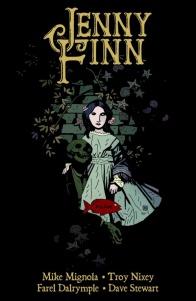
Troy Nixey co-wrote “Jenny Finn” with Mignola and drew the first three issues of the four-issue series.
‘The printing has improved significantly, so a lot of my fine linework that was lost on the newsprint of the initial run will be seen for the first time,’ said Nixey of the reprint. ‘The biggest difference of course is the addition of Dave Stewart to the mix. The colors he’s added to the work are remarkable. We had always hoped “Jenny Finn” would eventually be colored, and there’s no one better than Dave to make that happen.’*
‘I do think because Troy’s artwork is very detailed, very busy, I think color makes it a lot easier to read,’ said Mignola. ‘It worked fine in black and white, but it didn’t look like like a book that needed to be in black and white. There’s a feel that Dave [Stewart] brings to that. Because you have those plague victims with fish sticking out of their faces and just so many odd things where color just adds something. I’m happy to have it back out there. I’ve done some weird shit, but “Jenny Finn” is one of the weirder things I’ve done.’

‘Given what we’ve done with Baltimore, or, The Steadfast Tin Soldier and the Vampire and Joe Golem and the Drowning City, I figured we’d treat this one the same way. This one, unlike Baltimore and Joe Golem, I had almost no plot for. My contribution was the name. This was actually something that I thought I’d do in either “Lobster Johnson” or in a book that’d be a companion to “Lobster Johnson.” I had this vision of this other pulp character—the moment is in the book—but all I had for Grim Death was this scene where we’d start with this scary death face staring out at the reader, saying something very ominous and Shadow-like, and we’d pull back from that you’d see that it’s a guy practising in the mirror and he wouldn’t have his pants on. And because this was early days, I was still imagining Guy Davis drawing that. It seemed to me like such a Guy Davis gag, just because I knew the way Guy would draw this dumpy guy with the boxers on with the socks held up with the garters. That’s all I ever made up for that book.’
When Sniegoski came on board, the project came to life. ‘It was on the shelf, something I never planned to do anything with…’ said Mignola. ‘I can’t remember if Tom approached me about it or I approached Tom about it, but it was such an absurd idea that I thought it was more of a Tom Sniegoski than a Chris Golden idea. Tom is a guy that’s just gonna laugh hysterically about having monkeys do stuff.
Continued below‘Tom liked the idea, and I think I may have come up with some vague origin for the character. As with Chris, we banged this stuff back and forth on the phone, to the point that I can’t remember who came up with what, but the actual adventure with the carnival and stuff like that, that was all Tom. I had nothing at all to do with that.’
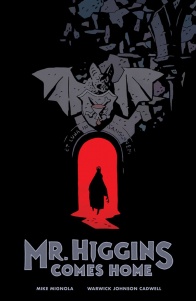
‘It came about entirely because Warwick [Johnson-Cadwell] and I were on a panel together in a show in England. I’d never met him before, but I loved his work, but I had never thought of working with him. The guy who was running the panel we were on made a couple of references to Warwick drawing sad werewolves, so I had sad werewolves in my head. I came home from England, looked on Facebook one day and Warwick had drawn some kind of vampire hunter character, and I went, “Hey, let’s do a book together about a vampire hunter and a sad werewolf.” It was literally that simple.’
For Mignola, the book was a chance to play with elements from stories he loves. ‘When I think of werewolves and vampire hunters, I immediately go to my favorite vampire movie, The Fearless Vampire Killers and any Hammer vampire movies. It was very obviously my take on those things. It was really easy and really fast. It was kinda like the way I wrote “The Amazing Screw-On Head” stuff where I just made up a serious of absurd things. When it came to scripting it, it was just coming up with dialogue as fast as humanly possible. It was very fast… except for the last page.’
‘I had to write to the artist,’ said Mignola of his collaboration with Johnson-Cadwell. ‘I’d never worked with him before, but I was familiar enough with his work. This thing has to be a little bit broad and it has to go really fast because there’s so much energy in his work. I couldn’t do this kinda slow, quiet, moody stuff. I couldn’t make it a subtle story. I could have actually done that book straight. If I had thought of that plot ten years ago, I could have drawn it. The dialogue would be a little different, but the plot, as absurd as it is, I could see doing it perfectly straight. It would be weird and a little bit goofy, but it’s made out of the shit I love. In my work, I’ve never really done my obvious love letter to that gothic stuff.
‘The beauty of the way I work—I write a plot and then I script it later—there were places where I thought I’d have to write more, but Warwick, considering how broad his artwork is, managed so many nice, little weird moments. I think I had Satan actually saying goodbye to these guys, but there’s a panel Warrick drew where Satan’s just waving goodbye and it’s so perfect. I didn’t have to write anything there.’


‘The famous wisdom on endings is that a good one is both surprising and inevitable, and I think we achieved that,’ said Golden. ‘When I’d decided, while writing Volume 5, what Volumes 6, 7, and 8 would look like, I called Mike immediately and we talked it through. I was thrilled to find that not only was he on board with “The Red Kingdom,” but that he wanted to take it further than I’d suggested. It all grew organically from the idea of what the world would be like when the Red King had taken flesh and walked among us—in Europe in the 1920s. This was the fulfillment of the story we’d started in the novel. I’m sure we could have dragged that arc out into a couple of additional volumes—hell, we could have gone on with it for years—but in “Baltimore,” as with my novels, I’m disenchanted with such endings. It’s my firm belief that once the audience has it all figured out, you’re just wasting their time, and the more you let the climax drag on, the less climactic it feels. I’d rather deliver the knockout and walk away than win by TKO.’
Continued below‘I do bat the plots back and forth a little,’ said Mignola of working with Golden, ‘but mostly the storyline is generated by Chris. We talk about it, I make some suggestions, but I don’t think any big story beats come from me. Chris comes up with it, I try to Mignola-ize it a little bit, but both “Baltimore” and “Joe Golem” are very much Chris driven. I was a little bit more involved in the “Baltimore” comic in the beginning, but the “Joe Golem” thing, my involvement pretty much ended with the novel. Those are Chris’s babies.’

For Peter Bergting, the artist tasked with drawing “The Red Kingdom,” quite a challenge lay ahead.
‘Drawing the WWI stuff was awesome,’ said Bergting. ‘Scott gave me a lot of feedback along the way, especially to make it really gritty. Every once in a while there’d be a panel he really liked and I tried pushing for that. I work digitally but my brushwork got grittier, and I guess more confident as I neared the end. But there were some really juicy scenes in the script where I really had to push what I was able to do. Like there suddenly appearing giant tentacled blobs in the midst of war where there’s already hell hounds, vampires and witches on the battlefield. Also, I suggested the full page spread to Scott and he was like, “No, we don’t like spreads,” and then changed his mind. At which point I had changed my mind about it. That spread took forever to finish and working digitally it’s hard to get a scope on a scene that big.’
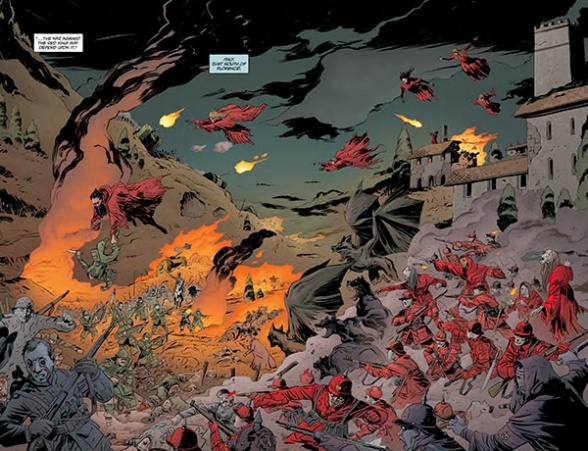
One of the big surprises in “The Red Kingdom” was the five-year time jump since “Empty Graves,” and not just for readers.
‘The time jump came as a bit of a surprise to me,’ revealed Bergting. ‘We went back to the art and the script to add in a few nuggets to sell the idea that the world had gone really dark during those years. I think this is where we added the prologue as well to also make it more relevant compared to what’s going on in the world today.’
‘Scott Allie and Mike and I were startled to discover how much the story arc mirrored what was happening in the real world,’ said Golden. ‘While I was writing the first issue, it was not in my mind at all—or not much. But over the period during which I’d written the first issue, then the second issue, and was writing the third, the world was changing—or being revealed. Scott had wanted me to add a page or two to the beginning of the first issue to remind the audience of what’s come before and the state of the world, and so we added that lead-in, which draws the comparison to the present day reality into even sharper comparison with the world we’d created.’
Continued below
Golden enumerated three reasons for the time jump. ‘First, in the novel, we purposely left a similar space in which we didn’t show you what Baltimore was up to, so that we could come back later and fill in that space with smaller stories. Now we’ve got a period of years during which Baltimore was on his own, away from the familiar comrades, but we have no idea what he was doing during those years while the Red King spread his kingdom across Europe. We can always go back and tell those stories. Second, we needed time for the Red Kingdom to grow organically, so that it’s as enormous a threat as we discover it to be when the story arc begins.’
The third reason was a little more complicated, and had to do with the timeline laid out in Joe Golem and the Drowning City, in particular the 1925 earthquakes that led to the flooding of lower Manhattan.
‘The earthquake was in the novel and Chris just stretched the “Baltimore” story time-wise so it would line up with that,’ said Mignola.
‘Enough time has passed now that I don’t mind just stating this stuff flatly. Not only is the end of “Baltimore” the same year as the flooding of lower Manhattan in “Joe Golem”… it’s the same day,’ revealed Golden. ‘The deaths at the end of “Baltimore” are the literal cause of the global cataclysm that included the earthquake in New York and a variety of other “natural” disasters that have yet to be revealed.’
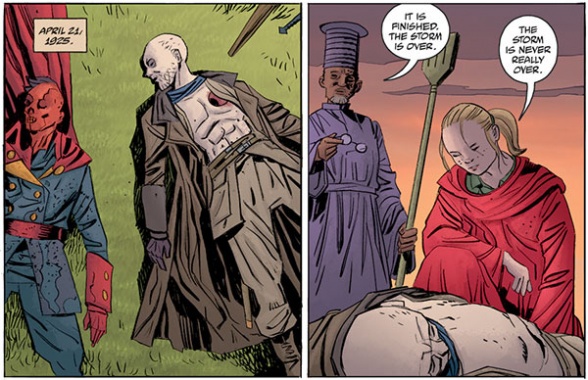
Obviously, the ramifications are huge. With “Baltimore” and “Joe Golem” existing in the same universe, certain story beats have a whole new dimension to them.
‘If you think about the way World War I woke some of the ancient evils, directly leading to the waking of the Red King, and drawing the Red King’s attention, then yeah, I certainly think the events of “Baltimore” might have drawn attention from beyond the veil of the world,’ mused Golden. ‘That said, the actions of a couple of other characters also draw that attention in a much more immediate way, which readers of Joe Golem and the Drowning City will know.’
‘I had no idea this was a shared universe,’ said Bergting. ‘To be honest, I thought all Mike’s books were set in the same universe, but at different time periods, so not really “shared” but still… I mean, Hellboy showed up in that Batman/Starman comic so I really didn’t think about it.’
‘I think I knew that this was a shared universe pretty early on,’ said “Joe Golem” artist, Patric Reynolds, ‘but If I remember correctly I actually heard it from “Hellboy and the B.P.R.D.” writer Chris Roberson. We were at a party sometime in the year 2015 and he asked me what I was currently working on, and I said “Joe Golem!” and he replied, “Oh! That kind of shares a universe with “Baltimore,” right?” and I said “Uh…. SURE!”
‘I got the confirmation when I read the script for the third issue of “The Ratcatcher,” and came across a flashback scene that took place in 15th century Croatia that opened up on a shot of an old mill with occult symbols painted on it. Christopher Golden left a note that they should be the same symbols that appeared in “Baltimore.”

‘I remember having to add the symbols in another scene in one of the “Outer Dark” issues, but I think the knowledge of the shared universe most affected the way I depicted the witches going forward. At first I based the witches off of meth-addicts and lepers, to make it seem like they were just humans that were afflicted with… something. But as I went along and dove back into the original Joe Golem and the Drowning City and read the passages with the witches (and descriptions of their long bony fingers scratching at the golem) and re-examining Mike’s spot illustrations, I kept getting images of old, scraggly bare trees in my head. I thought I’d sort tweak them with that metaphor in mind—making them more thin, lanky, and whispy-looking to sort of call back to those bare winter trees on that Croatian riverbank where they first entered my mind as I read the novel. I thought basing them less on real people and making them a little more abstract and graphic might help better connect the two universes, and make my depictions of them line up with whole Mignolaverse a little better.’
Continued below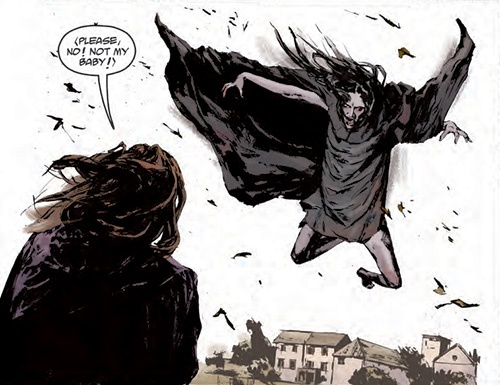
Mignola recalled how the shared universe first came about. ‘It was probably around the time Chris started doing the “Joe Golem” comic that he started playing with the idea of them being a shared universe. It wasn’t my idea, I had nothing against the idea, I didn’t know how obvious he wanted to make it. I still don’t know how obvious he wants to make it. That kind of stuff is cute if the informed reader goes, “Oh, cool! I get what you’re doing!” but I don’t see him doing a crossover.’

During our interview, I referred to the Baltimore and Joe Golem shared universe as ‘The Red Plague Universe’ to differentiate between it and the Hellboy Universe, but Golden felt this term wasn’t quite right.
‘I have no objection to giving this shared universe a name,’ he said, ‘although I think your suggestion puts too much emphasis on the Red Plague. The history of the golem goes back much further—and who knows what else will come up?’
Indeed, the universe is wide open. Be sure to check in tomorrow as we take a closer look at Patric Reynolds’s art on “Joe Golem, Occult Detective: Flesh and Blood” #1.
*Troy Nixey’s comment on “Jenny Finn” was originally from Anelise Farris’s interview with him on Rogues Portal.






